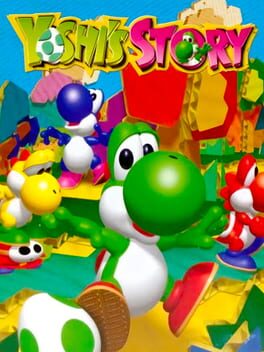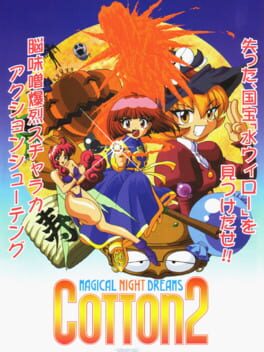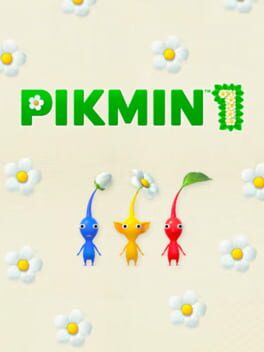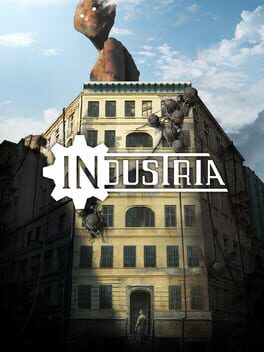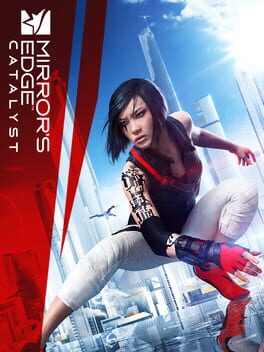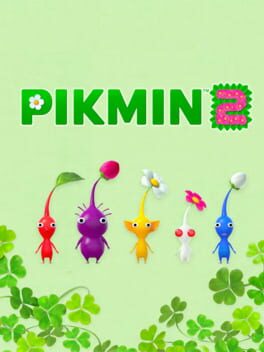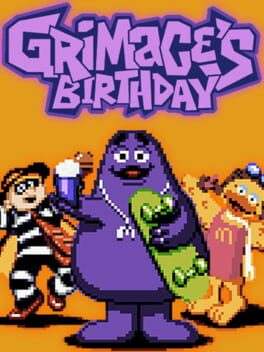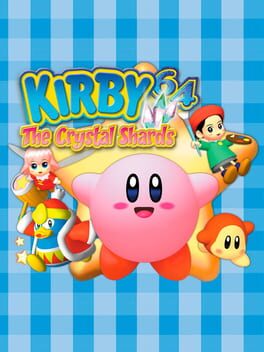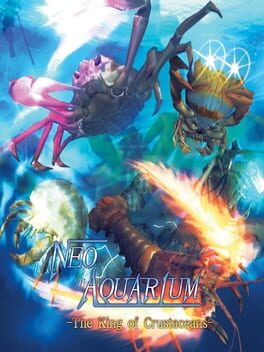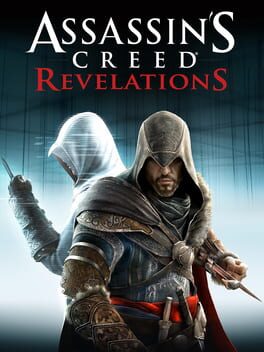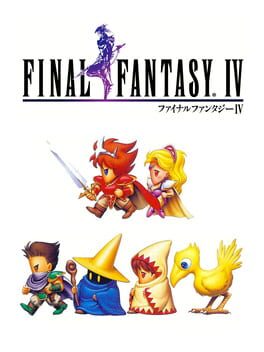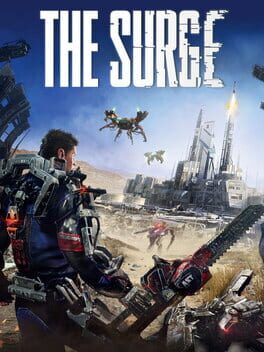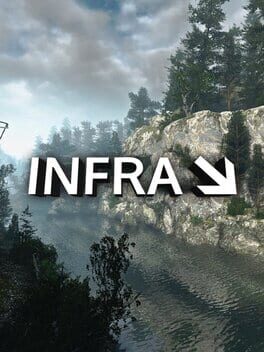Spacelung
1997
This ended up being pretty different from Yoshi's Island despite the surface similarities, which I was not expecting. Its a cute little game with some creative ideas and probably the nicest looking 2D visuals on the N64 (though you kinda need a CRT tv or a good CRT filter in an emulator for it to look its best, the raw pixels look kinda gross at times without it like most games that use prerendered sprites, whereas the CRT blending effect smooths that out and makes it look like an illustration). There's a cartoon elasticity to the animations, and all kinds of lively little touches, its really a cute and energetic game visually. The music is also really great with all kinds of strange songs, including some with like this weird beatboxing. Also the yoshis sing and it is heart meltingly-cute.
You get 6 yoshis that are gone permanently if they "die" which is kinda wild considering the storybook, kid's game aesthetic. Kids love permadeath! There are 6 worlds and you get to choose one level per world on each playthrough, meaning each playthrough can be a totally different sequence of levels. Each level is based around exploring enough to gather 20 fruits, and then it ends. Its a neat way to structure a platformer that I've never seen before.
Not as classic as Yoshi's Island but its a weird, creative offshoot with a lot of heart and I enjoyed playing it quite a bit.
You get 6 yoshis that are gone permanently if they "die" which is kinda wild considering the storybook, kid's game aesthetic. Kids love permadeath! There are 6 worlds and you get to choose one level per world on each playthrough, meaning each playthrough can be a totally different sequence of levels. Each level is based around exploring enough to gather 20 fruits, and then it ends. Its a neat way to structure a platformer that I've never seen before.
Not as classic as Yoshi's Island but its a weird, creative offshoot with a lot of heart and I enjoyed playing it quite a bit.
I played the Sega Saturn port via emulation, which has a fan-translated english language patch available.
This is an extremely solid shmup. You're a little witch girl whois very rude, and aside from various elemental magics you can also grab nearly any enemy or object and chuck it at other enemies. It rules and more shmups should do this. If you play well and avoid damage, you'll level up and you can get to the point where your magic just has these super powerful effects, like the ice chaining to nearby enemies. The story is also super well presented with like these really high energy animated manga panels/portraits of the characters that zoom around and bounce off and slap each other. The art is big time goofy 90s anime, real fun stuff. The in-game art is also really detailed, nice 2D. The monsters are full of cartoon liveliness, especially the bosses.
Overall a fun and cute shmup with some really fun mechanics and a mountain of personality.
This is an extremely solid shmup. You're a little witch girl whois very rude, and aside from various elemental magics you can also grab nearly any enemy or object and chuck it at other enemies. It rules and more shmups should do this. If you play well and avoid damage, you'll level up and you can get to the point where your magic just has these super powerful effects, like the ice chaining to nearby enemies. The story is also super well presented with like these really high energy animated manga panels/portraits of the characters that zoom around and bounce off and slap each other. The art is big time goofy 90s anime, real fun stuff. The in-game art is also really detailed, nice 2D. The monsters are full of cartoon liveliness, especially the bosses.
Overall a fun and cute shmup with some really fun mechanics and a mountain of personality.
2023
The only part of this game that doesn't perfectly hold up is how your Pikmin are just the dumbest little bitches on the forest floor and have pathfinding so bad its a miracle they survived on this planet without Olimar to look after them. They seem to go out of their way to get stuck behind things that are not in their way, they walk into fire, they fall off ledges they aren't even near, grab stuff you didn't tell them to, and try to help carry things only to randomly give up and just be left behind as an idle trail of pale fools lounging about as their friends do all the work. Several times i saved them from drowning only for them to literally go out of their way to run back into the water and finish drowning. They are always getting caught up in a nectar frenzy and hanging out under ramps and bridges cause they wandered in there and couldn't get back out. I was at my wits end dealing with these little freaks. And yet.... they are still my precious little idiot vegetable murder children, the bane of my days on this fallen earth, and I love them so much.
Shoutout to the mockingly loopy circus clown music in the final trial level for perfectly capturing the mental state i was in after dealing with the endless carrot-brained shenanigans of 100 primary colored nincompoops all day.
Shoutout to the mockingly loopy circus clown music in the final trial level for perfectly capturing the mental state i was in after dealing with the endless carrot-brained shenanigans of 100 primary colored nincompoops all day.
2021
This feels like a piece of good scifi short fiction in game form. Great melancholy, mysterious vibes, but just a little underbaked feeling in the end, like it could have used another couple months of polish with regard to performance and some of set-dressing of the later levels. Performance issues aside though its a really gorgeous looking and sounding game and I enjoyed my time with it, and I will def keep an eye on what Bleakmill does next. More short games that swing as big as this one did production-wise, please.
Mirror's Edge: Catalyst feels like it never gets talked about except for through lamentations of it being open world instead of level based like the original Mirror's Edge was, or people complaining about how it has a couple movement abilities locked behind a skill tree, or people talking about how EA doesnt make original games anymore. And I get that position on paper, since Mirror's Edge: Catalyst came out right in the middle of the ps4 generation when open worlds were everywhere in AAA and every game seemed to have an obligatory skill tree regardless of whether it added anything of value. I can't blame people seeing a sequel to a really tight, linear, level based game going open world and throwing up their hands about Trends and Bandwagons.
But here's the thing. This game is barely an open world in the Ubisoft sense or the GTA sense. Rather, I think it has a lot more in common with the Metroidvania genre.
Mirror's Edge is about parkour, or free running, in a dystopian future. Everything about the gameplay and theming is centered on these two ideas. What this means for its "open world" design is that you have several decently sized but not huge sections of city, largely rooftops, interiors of buildings, some infrastructural installations, and a construction site, that is all there to facilitate free, expressive movement, often while escaping from The Cops. No matter what route you take, you are always pushed to engage with the detailed and active parkour mechanics. This isn't like the other big Parkour game, Assassin's Creed, where you just hold a button and occasionally another button while moving and your guy does it all automatically (not a knock tho, I love AC). Its stick-shift platforming and it's a ton of fun. The mechanics have been slightly refined from the original game and provide more ways to enter a state of rapid, flowing movement, or recover it if you fuck up. Every route you take becomes a chain of vaults, slides, jumps, wall-runs, impact rolls, and swings off pipes and flagpoles. New to this game is a shift move that works both as a dodge and a way to build, rebuild, or maintain momentum, that I found myself using in a way that almost simulated the rhythmic, controlled breathing of distance running. Tying it all together is the absolutely unparalleled design of full-body presence in its first person viewpoint, where it not only shows your body when you look down but actually makes it feel like you're inhabiting and moving in it, with the weight and momentum and grace of an athlete in motion, instead of just a floating camera with arms like so many other first person games. There are honestly very few AAA games that care about detailed, flavorful movement mechanics to this degree.
The combat is vastly improved from the first game, where clunky fighting or shooting segments often brought the game's beautiful momentum to a screeching halt. In this one, you can no longer use guns, thank god, so its all punching(light attacks) and kicking(heavy attacks). The new shift-dodge means you can more easily avoid damage, and also get behind them to do extra damage or kick them off ledges. But the key to combat is traversal attacks, which is when you attack while doing parkour. Light ones do less damage but preserve your momentum, so they're good for getting enemies out of your way while escaping, or for setting them up for a knockout from a stronger heavy traversal attack. These attacks are snappy and well-animated, and the combat is actually quite satisfying once you get the hang of incorporating parkour into it. There are several enemy types that all require slightly different tactics, so it keeps things from getting stale. The combat is also very frequently optional; you can often simply bowl them over and get the heck out of there instead.
The game does contain a skill tree, but it is honestly quite unobtrusive. It has 3 parts: movement, combat, and gear, and 80% of the movement tree is unlocked already at the start of the game, with the majority of the rest of the actual parkour mechanics easily unlocked in an hour or two of play. The rest of it is all combat skills, damage or defense upgrades, and new gadgets. The gadgets you actually just get from story progression, and they give you new movement abilities that open up new paths and new areas as the story progresses. Its not quite as free-form in its exploration as traditional Metroidvanias, and there's no sequence breaking due to the mission-based story, but it still has that feeling of the world gradually unfolding as your abilities grow. The map contains some of the typical open-world collectables and busywork missions, which are usually time trials, timed deliveries, or small combat challenges followed by escapes. They're fun enough to do, but can be safely ignored without consequence if you aren't interested or just want a more tightly paced game. The story missions themselves, and the character-given major sidequests, are all very solid and bring you to a variety of more linear, contained levels scattered around the city. This stuff is classic Mirror's Edge, and where the game shines brightest. I especially liked the Art Museum level and the under-construction skyscraper you have to sabotage for the mafia.
Like the original game, Mirror's Edge Catalyst is a real looker. It paints its world in splashes of vivid color against stark, sterile white and polished glass. The use of color is a bit more restrained here compared to the first game, but its still very effective. Sometimes you slam open a door from the blindingly white rooftops and are blasted with the most incredible shade of green you've ever seen in a game as you sprint through an office corridor to the closest exit. Huge video billboards or displays cover buildings, with constantly shifting advertisements or news reports lighting up the night. It feels lightly futuristic and dystopian in a way that balances mundane believablility with stylized hyper-reality really well. There are some really lovingly crafted service corridors, corporate office buildings, and infrastructural facilities; mundane places transformed and made stranger by the context of how you move through them and why, which is something I always love to see in games (see also: INFRA, for the ultimate perfection of this aesthetic in games). The sound design is quite immersive, and makes you feel the speed and physical exertion involved in everything you do. The music on the other hand is only OK, as it serves the atmosphere and action well, but isn't especially memorable. They commissioned a pretty solid CHVRCHES song but bafflingly, don't even use it at all other than in a jukebox in the hideout. It doesn't even play over the credits! Why even commission it then!!
The narrative is fine. It's not like poorly executed, but its nothing new either. Kinda feels like a middling TV show from that time period. It provides a solid enough framework for a bunch of cool levels, so I guess it did its job. It is at least, better than the absolutely atrocious storytelling from the original game with its e-surance cutscenes and barely sketched characters. The characters here feel like people with a history in this world, and the presentation is solid, it just lacks a certain extra spark. Even so, it's well-paced and doesn't overstay its welcome by any means.
Mirror's Edge: Catalyst is a seriously underrated game. It doesn't quite hit the transcendent highs the original does, but it also comes nowhere near that game's very low low points either. It is simply a good time, and it really deserved better than the low sales and critical dismissal it seems to have gotten when it came out. If you like deep first person movement I highly recommend it.
But here's the thing. This game is barely an open world in the Ubisoft sense or the GTA sense. Rather, I think it has a lot more in common with the Metroidvania genre.
Mirror's Edge is about parkour, or free running, in a dystopian future. Everything about the gameplay and theming is centered on these two ideas. What this means for its "open world" design is that you have several decently sized but not huge sections of city, largely rooftops, interiors of buildings, some infrastructural installations, and a construction site, that is all there to facilitate free, expressive movement, often while escaping from The Cops. No matter what route you take, you are always pushed to engage with the detailed and active parkour mechanics. This isn't like the other big Parkour game, Assassin's Creed, where you just hold a button and occasionally another button while moving and your guy does it all automatically (not a knock tho, I love AC). Its stick-shift platforming and it's a ton of fun. The mechanics have been slightly refined from the original game and provide more ways to enter a state of rapid, flowing movement, or recover it if you fuck up. Every route you take becomes a chain of vaults, slides, jumps, wall-runs, impact rolls, and swings off pipes and flagpoles. New to this game is a shift move that works both as a dodge and a way to build, rebuild, or maintain momentum, that I found myself using in a way that almost simulated the rhythmic, controlled breathing of distance running. Tying it all together is the absolutely unparalleled design of full-body presence in its first person viewpoint, where it not only shows your body when you look down but actually makes it feel like you're inhabiting and moving in it, with the weight and momentum and grace of an athlete in motion, instead of just a floating camera with arms like so many other first person games. There are honestly very few AAA games that care about detailed, flavorful movement mechanics to this degree.
The combat is vastly improved from the first game, where clunky fighting or shooting segments often brought the game's beautiful momentum to a screeching halt. In this one, you can no longer use guns, thank god, so its all punching(light attacks) and kicking(heavy attacks). The new shift-dodge means you can more easily avoid damage, and also get behind them to do extra damage or kick them off ledges. But the key to combat is traversal attacks, which is when you attack while doing parkour. Light ones do less damage but preserve your momentum, so they're good for getting enemies out of your way while escaping, or for setting them up for a knockout from a stronger heavy traversal attack. These attacks are snappy and well-animated, and the combat is actually quite satisfying once you get the hang of incorporating parkour into it. There are several enemy types that all require slightly different tactics, so it keeps things from getting stale. The combat is also very frequently optional; you can often simply bowl them over and get the heck out of there instead.
The game does contain a skill tree, but it is honestly quite unobtrusive. It has 3 parts: movement, combat, and gear, and 80% of the movement tree is unlocked already at the start of the game, with the majority of the rest of the actual parkour mechanics easily unlocked in an hour or two of play. The rest of it is all combat skills, damage or defense upgrades, and new gadgets. The gadgets you actually just get from story progression, and they give you new movement abilities that open up new paths and new areas as the story progresses. Its not quite as free-form in its exploration as traditional Metroidvanias, and there's no sequence breaking due to the mission-based story, but it still has that feeling of the world gradually unfolding as your abilities grow. The map contains some of the typical open-world collectables and busywork missions, which are usually time trials, timed deliveries, or small combat challenges followed by escapes. They're fun enough to do, but can be safely ignored without consequence if you aren't interested or just want a more tightly paced game. The story missions themselves, and the character-given major sidequests, are all very solid and bring you to a variety of more linear, contained levels scattered around the city. This stuff is classic Mirror's Edge, and where the game shines brightest. I especially liked the Art Museum level and the under-construction skyscraper you have to sabotage for the mafia.
Like the original game, Mirror's Edge Catalyst is a real looker. It paints its world in splashes of vivid color against stark, sterile white and polished glass. The use of color is a bit more restrained here compared to the first game, but its still very effective. Sometimes you slam open a door from the blindingly white rooftops and are blasted with the most incredible shade of green you've ever seen in a game as you sprint through an office corridor to the closest exit. Huge video billboards or displays cover buildings, with constantly shifting advertisements or news reports lighting up the night. It feels lightly futuristic and dystopian in a way that balances mundane believablility with stylized hyper-reality really well. There are some really lovingly crafted service corridors, corporate office buildings, and infrastructural facilities; mundane places transformed and made stranger by the context of how you move through them and why, which is something I always love to see in games (see also: INFRA, for the ultimate perfection of this aesthetic in games). The sound design is quite immersive, and makes you feel the speed and physical exertion involved in everything you do. The music on the other hand is only OK, as it serves the atmosphere and action well, but isn't especially memorable. They commissioned a pretty solid CHVRCHES song but bafflingly, don't even use it at all other than in a jukebox in the hideout. It doesn't even play over the credits! Why even commission it then!!
The narrative is fine. It's not like poorly executed, but its nothing new either. Kinda feels like a middling TV show from that time period. It provides a solid enough framework for a bunch of cool levels, so I guess it did its job. It is at least, better than the absolutely atrocious storytelling from the original game with its e-surance cutscenes and barely sketched characters. The characters here feel like people with a history in this world, and the presentation is solid, it just lacks a certain extra spark. Even so, it's well-paced and doesn't overstay its welcome by any means.
Mirror's Edge: Catalyst is a seriously underrated game. It doesn't quite hit the transcendent highs the original does, but it also comes nowhere near that game's very low low points either. It is simply a good time, and it really deserved better than the low sales and critical dismissal it seems to have gotten when it came out. If you like deep first person movement I highly recommend it.
2023
This is a real two steps forward, one step back kind of game. It improves on Pikmin 1's mechanics in almost every way, especially with the Pikmin's AI and pathfinding (though its still not perfect), it looks and sounds excellent, and the level design of the surface areas is great. The issues come in when you enter the dungeons.
On paper the idea of a pikmin dungeon crawler with a big emphasis on endurance through smart strategy and resources management is a pretty interesting idea, but the execution is really uneven. The lack of a timer means that the pressure of there being consequences from inefficient play, or for getting careless and losing pikmin, exists almost entirely just in the dungeons. The easier ones are a little too easy, and the difficult ones can feel a bit cheap and unfair. Their semi-procedurally generated nature means the level design can be very iffy in terms of encounter design placement of treasure, and the later ones tend to pull a lot of "Surprise! Something randomly fell from the sky and will instantly kill dozens of your pikmin if you're unlucky or weren't expecting it" type of tricks. There are a lot of pointless gates with nothing but blank walls behind them. The fact that you can only get white and purple pikmin in dungeons is also pretty annoying, because if you lose a bunch it can be really tedious to get more of them. Purples especially can only be reliably gained through egregious amounts of grinding in very specific dungeons. It all feels a bit underbaked. The dungeons arent all bad, and most of them have a couple more hand-designed floors that stand out, plus there's the Submerged Castle with its highly terrifying gimmick. But the dungeon issues are enough to drag the game down a bit.
Having 2 captains is a good idea, but it ultimately doesn't actually do much with this mechanic since there's no way to tell them to go somewhere on their own other than having them lie down so pikmin bring them back to the ship. Occasionally you have to position them to relay-throw pikmin up a series of ledges, or weight-activated platforms, but it again, feels a bit underbaked.
One of my favorite parts of Pikmin 2 though is the creature design, and the piklopedia. The descriptions of all the creatures and items from Olimar and the ship's AI add a ton of flavor to the world. The creatures themselves are much more varied than the first game, with plenty of new ones and some variants of old ones. Some are only seen once or twice, and the illusion of a larger ecosystem is very well crafted. Their animation and sound design is fantastic and strikes a perfect balance of cute, weird, and upsetting. Shoutout to what a horrifying concept bulbmin are.
When i was a kid, I liked this sequel more than Pikmin 1, because it felt like a vast world full of hidden secrets and dangers. And it does still evoke some of that feeling even now! But I think in trying to go bigger they created a lush, alive world to explore but spread themselves too thin and lost a lot of the first game's tension and the magic it created.
On paper the idea of a pikmin dungeon crawler with a big emphasis on endurance through smart strategy and resources management is a pretty interesting idea, but the execution is really uneven. The lack of a timer means that the pressure of there being consequences from inefficient play, or for getting careless and losing pikmin, exists almost entirely just in the dungeons. The easier ones are a little too easy, and the difficult ones can feel a bit cheap and unfair. Their semi-procedurally generated nature means the level design can be very iffy in terms of encounter design placement of treasure, and the later ones tend to pull a lot of "Surprise! Something randomly fell from the sky and will instantly kill dozens of your pikmin if you're unlucky or weren't expecting it" type of tricks. There are a lot of pointless gates with nothing but blank walls behind them. The fact that you can only get white and purple pikmin in dungeons is also pretty annoying, because if you lose a bunch it can be really tedious to get more of them. Purples especially can only be reliably gained through egregious amounts of grinding in very specific dungeons. It all feels a bit underbaked. The dungeons arent all bad, and most of them have a couple more hand-designed floors that stand out, plus there's the Submerged Castle with its highly terrifying gimmick. But the dungeon issues are enough to drag the game down a bit.
Having 2 captains is a good idea, but it ultimately doesn't actually do much with this mechanic since there's no way to tell them to go somewhere on their own other than having them lie down so pikmin bring them back to the ship. Occasionally you have to position them to relay-throw pikmin up a series of ledges, or weight-activated platforms, but it again, feels a bit underbaked.
One of my favorite parts of Pikmin 2 though is the creature design, and the piklopedia. The descriptions of all the creatures and items from Olimar and the ship's AI add a ton of flavor to the world. The creatures themselves are much more varied than the first game, with plenty of new ones and some variants of old ones. Some are only seen once or twice, and the illusion of a larger ecosystem is very well crafted. Their animation and sound design is fantastic and strikes a perfect balance of cute, weird, and upsetting. Shoutout to what a horrifying concept bulbmin are.
When i was a kid, I liked this sequel more than Pikmin 1, because it felt like a vast world full of hidden secrets and dangers. And it does still evoke some of that feeling even now! But I think in trying to go bigger they created a lush, alive world to explore but spread themselves too thin and lost a lot of the first game's tension and the magic it created.
2023
One of the best Kirbies! The power-combo system is pretty fun and leads some really creative powers, and the level design is really varied and snappy. Has a little bit of a higher challenge level than most kirby games in the later stages and bosses. It is just completely gorgeous too, one of the most gracefully aged N64 games for sure due to its smart use of bright, bold shapes. Looks like a living illustration sometimes. And the music fuckin RIPS, like there are some real bangers in there. Good as heck game.
2023
That caked up bunny-goat-cat woman really has some radical moves. This is one of the few 3D metroidvanias that actually captures the feeling of 2D metroidvania exploration. Does 3D Castlevania better than any of the actual 3D Castlevanias.... its Castlevania 64, but good (and I say this as a pretty big fan of Castlevania 64). The movement is super rich and expressive, and the level design is both interesting to explore and surprisingly evocative considering how simple it is visually. The soundtrack is all bangers. Its just a really well made little game and I liked it a lot!
This feels more like an actual sequel to the previous 2 than another direct continuation like Brotherhood was. The visuals and feel of the controls are much better, and the presentation is mostly great. Istanbul/Constantinople is an amazingly atmospheric and textured setting, and I appreciate the smaller scope of it. The stealth here is better too, since you can see guard routes, and the bombs add a lot of possibilities even if they're kind of a pain to deal with when you want to switch them out. The hookblade is a great addition to movement, which just feels better and more responsive in general. The story with Old Ezio mostly works, and I loved the interludes with Altair that finally make him an interesting character, but it feels like development got cut short or ran out of time/budget cause it truly drops the ball in the final act on everything other than Ezio and Altair's personal endings. I cant believe they did my dude Yusuf so dirty like that! The present day stuff is weird this time since Desmond is in a coma inside the animus, so most of it is pretty abstract. So abstract it even has an entire abstract dreamscape-brutalist first person narrative puzzle game in there to deliver that story through! Which is maybe the most 2011 thing I have ever seen in a game. The puzzle levels are pretty good though, honestly, so ultimately I respect them for making that very strange choice. Why not! Anyway, this one plays the best of the Ezio games and I liked his actual ending a lot, but the rest of that final 1/4 of the game being so weirdly truncated and sloppy prevents it from being the best of the trilogy.
1991
Played via the "Namingway Edition" fan retranslation/restoration romhack that restores everthing cut from the original NA SNES version.
A bit archaic in 2021, this one is kinda simplistic especially compared to later FFs. It is 29 years old after all. But this is also a strength of the game because it gives it a really zippy pace and makes the battles into quick little puzzles to solve (or to just cast megaflare to skip lmao). Its a JRPG you can beat in under 30 hours, or even less if you really know what you're doing!
The characters and story are pretty basic fantasy fare barring some bizarre twists later on but it has a certain iconic/archetypal charm to it and the monster sprites are always great to look at. You definitely get the sense that they were figuring out a lot of things about how to tell dramatic stories in games with this one. It's also not especially difficult until the very late-game stuff, and I didn't have to grind a single time in order to beat it. If you make full use of your party's abilities and spells, there's always some kind of solution to figure out a path to victory even if only by the skin of your teeth, which makes the difficulty feel really well tuned to me, for the most part.
The music has great melodies but the like, instrumentation of it is pretty harsh and tinny and the songs are mostly all less than a minute long. This is probably my biggest complaint with the game besides the barebones, clunky early SNES RPG UI, cause after an hour or two of playing the music really starts to grate. Sure is catchy though.
Anyway good game, love to ride a whale to the moon
A bit archaic in 2021, this one is kinda simplistic especially compared to later FFs. It is 29 years old after all. But this is also a strength of the game because it gives it a really zippy pace and makes the battles into quick little puzzles to solve (or to just cast megaflare to skip lmao). Its a JRPG you can beat in under 30 hours, or even less if you really know what you're doing!
The characters and story are pretty basic fantasy fare barring some bizarre twists later on but it has a certain iconic/archetypal charm to it and the monster sprites are always great to look at. You definitely get the sense that they were figuring out a lot of things about how to tell dramatic stories in games with this one. It's also not especially difficult until the very late-game stuff, and I didn't have to grind a single time in order to beat it. If you make full use of your party's abilities and spells, there's always some kind of solution to figure out a path to victory even if only by the skin of your teeth, which makes the difficulty feel really well tuned to me, for the most part.
The music has great melodies but the like, instrumentation of it is pretty harsh and tinny and the songs are mostly all less than a minute long. This is probably my biggest complaint with the game besides the barebones, clunky early SNES RPG UI, cause after an hour or two of playing the music really starts to grate. Sure is catchy though.
Anyway good game, love to ride a whale to the moon
Assassin's Creed IV: Black Flag is a fine time. It is enjoyable. Occasionally it aims higher than just that, and does some weird or unique things just like previous AC games did, but largely it is Ubisoft taking the incredibly ambitious and unusual foundation laid by Assassin's Creed III, and shaping it into a larger and more normal open world game. The lows are less low, but the highs are also less high. This is the first of the AC games where I started to feel like the modern Ubisoft formula, that dominated their game design during the PS4 generation, was a more significant presence in the structure of the game.
The coolest thing about ACIV is also the biggest departure from previous games: the ships and crew and what that enables. You are a pirate captain and you have your own ship which you can sail on the high seas as you please, from island to island, hunting for treasure, battling the English and Spanish fleets and plundering them, raiding forts, and so on and so forth. The ocean looks incredible, and the feel of the ships in motion is very physical and tactile. Wind and waves and weather all have a big impact on your navigability and perception of whats around you, and they did a good job of translating this to a much more dynamic open world setup from the highly scripted ship missions of ACIII. The English and Spanish fleets (and the occasional other pirate crew) will battle if they encounter each other, regardless of whether you are involved, which goes a long way to make the oceans feel more alive. The flow of ship battles from cannon fire and maneuvering, to boarding and fighting man-to man, is a bit simple, and gets repetitive by the end of the game. Still, it works for making you feel like a swashbuckling captain, and can feel pretty satisfying and exciting when it all comes together just right. Your crew also sings sea shanties as you sail, which are one of the collectables you can find, and you bet your ass i got all the sea shanties in the game. My favorites were "Farewell, Spanish Ladies" and "Fish in the Sea." but they're all great, love to sing with the lads about how much the ocean sucks and how horny we are for all the ladies we haven't seen for weeks.
You can upgrade your ship to have more cannons and armor, and a bigger crew, but aside from cannons most of the upgrades don't feel especially meaningful, either mechanically or visually. Part of this is that I never made enough money to get many of the cosmetic upgrades, cause they really want you to do a ship management mini-game to make money. It has mobile game style timers and can only be accessed while on the ship, so it is generally a pain in the ass to keep on top of while doing other stuff. The other way to make money is to grind ship battles, which No I will not do that Ubisoft. Because of this my ship was never strong enough to really take on one of the legendary boss ships.
On-foot, its an evolution of what ACIII was doing, and while the combat feels a little worse (swords will never be as cool as Connor's dual tomahawk fighting style, sorry Edward), it is otherwise a bit more polished. Stealth in particular is much better here and feels smoother in general. While it is a bit simpler and relies more on the stalking zones, it largely avoids the issues ACIII had where you could easily get caught by accident because you got caught on something or the AI was just excessively observant, or there was nowhere to hide. Accidental failure is less common in general in ACIV. It also does not do the awful thing ACIII did where whole squads of redcoats would spawn in offscreen when you got caught, so that's nice. All the gameplay systems of combat, movement, stealth, are working in harmony here more than they ever had in the series up to this point.
There are several medium-sized cities and a ton of smaller islands, some of which contain jungles (which look awesomely lush for a 2013 game). Its still a lot of fun to move through the environments, and there are plenty of very natural feeling routes to make that work smoothly, slightly more so than in previous games I think. There's a pretty good variety of missions and setpieces and the main story does a good job of bringing you to new places and putting you in interesting situations. There are also a few underwater zones, which are awesomely atmospheric. These are mostly setpieces based around exploring wrecks for treasure while hiding from sharks and trying not to drown or get swept away by currents, so they are a bit simplistic, but its a nice change of pace and makes the ocean exploration feel a bit more robust.
The story itself is a bit of a mixed bag. It feels kind of scattered, like its missing some pieces. The sense of time passing is quite a bit more vague than previous games, which convolutes the pacing in the latter half of the game as things accelerate perhaps a bit too suddenly towards an ending. I imagine it was a bit rushed due to the yearly schedule AC was on at the time. I like the characters, and it hits all the classic pirate story beats you want to see but doesnt do nearly as good a job of exploring the Caribbean setting compared to previous AC games. It does ok with creating interesting gameplay that emerges from the specificity of the historical setting, but narratively and thematically it doesn't have nearly as compelling a viewpoint on the politics of the setting as ACIII did with Connor. I wish Adewale had a bigger role (though I know he got his own side game) beyond being like "Edward I love you bro but you are a huge dipshit." all the time, because he does get some of the better writing. I also wish we spent more time with the Central American assassin's brotherhood since their whole deal would have been very interesting to explore in more depth. Its also kind of a shame that there's no equivalent to the homestead characters from ACIII in this game, as your crew and the people at your hideout are largely just nameless set dressing, and the hideout here feels very much like it only exists because other games had it. The game does do a good job though in how it integrates the precursor civilization into the main story more directly. It ties into character motivations and worldbuilding throughout and leads to some fun story beats and gameplay.
The present day segments here really worked for me, though, and are quite different from previous games. What to do when Desmond is no longer around to provide an easy modern day viewpoint? Well they went buckwild with it and made a whole Abstergo Game Development Studio Office to explore, that is blatantly a thinly veiled parody of Ubisoft itself. You are an unnamed QA tester for the first commercial animus game, and you wander around the office in first person, and get talked at by execs and project managers between animus sessions. Eventually you also end up involved with uncovering precursor secrets, and some of the assassins from the other games coerce you into hacking computers and sneaking around. I love representations of real, "mundane" spaces in games and this is a very good one of those. The audio logs and other data you uncover by hacking also serve as a pretty interesting epilogue of sorts to Desmond's story. It feels like they were setting up a bunch of stuff for how the future games could handle the present day aspect, so I'm interested to see where it goes. The cyber ghost of Juno appearing from the server is a pretty wild moment, and is exactly the kind of goofy yet cool bullshit I want from AC's modern day segments.
So this is an AC that, while it takes some big swings of its own with the sailing and the weirdass present day stuff, it ends up feeling like they've sanded down a lot of the rough edges the series had, for better and worse. It's a very good game, but it doesnt quite justify its size, and it is not quite as memorable or interesting as its direct predecessor.
The coolest thing about ACIV is also the biggest departure from previous games: the ships and crew and what that enables. You are a pirate captain and you have your own ship which you can sail on the high seas as you please, from island to island, hunting for treasure, battling the English and Spanish fleets and plundering them, raiding forts, and so on and so forth. The ocean looks incredible, and the feel of the ships in motion is very physical and tactile. Wind and waves and weather all have a big impact on your navigability and perception of whats around you, and they did a good job of translating this to a much more dynamic open world setup from the highly scripted ship missions of ACIII. The English and Spanish fleets (and the occasional other pirate crew) will battle if they encounter each other, regardless of whether you are involved, which goes a long way to make the oceans feel more alive. The flow of ship battles from cannon fire and maneuvering, to boarding and fighting man-to man, is a bit simple, and gets repetitive by the end of the game. Still, it works for making you feel like a swashbuckling captain, and can feel pretty satisfying and exciting when it all comes together just right. Your crew also sings sea shanties as you sail, which are one of the collectables you can find, and you bet your ass i got all the sea shanties in the game. My favorites were "Farewell, Spanish Ladies" and "Fish in the Sea." but they're all great, love to sing with the lads about how much the ocean sucks and how horny we are for all the ladies we haven't seen for weeks.
You can upgrade your ship to have more cannons and armor, and a bigger crew, but aside from cannons most of the upgrades don't feel especially meaningful, either mechanically or visually. Part of this is that I never made enough money to get many of the cosmetic upgrades, cause they really want you to do a ship management mini-game to make money. It has mobile game style timers and can only be accessed while on the ship, so it is generally a pain in the ass to keep on top of while doing other stuff. The other way to make money is to grind ship battles, which No I will not do that Ubisoft. Because of this my ship was never strong enough to really take on one of the legendary boss ships.
On-foot, its an evolution of what ACIII was doing, and while the combat feels a little worse (swords will never be as cool as Connor's dual tomahawk fighting style, sorry Edward), it is otherwise a bit more polished. Stealth in particular is much better here and feels smoother in general. While it is a bit simpler and relies more on the stalking zones, it largely avoids the issues ACIII had where you could easily get caught by accident because you got caught on something or the AI was just excessively observant, or there was nowhere to hide. Accidental failure is less common in general in ACIV. It also does not do the awful thing ACIII did where whole squads of redcoats would spawn in offscreen when you got caught, so that's nice. All the gameplay systems of combat, movement, stealth, are working in harmony here more than they ever had in the series up to this point.
There are several medium-sized cities and a ton of smaller islands, some of which contain jungles (which look awesomely lush for a 2013 game). Its still a lot of fun to move through the environments, and there are plenty of very natural feeling routes to make that work smoothly, slightly more so than in previous games I think. There's a pretty good variety of missions and setpieces and the main story does a good job of bringing you to new places and putting you in interesting situations. There are also a few underwater zones, which are awesomely atmospheric. These are mostly setpieces based around exploring wrecks for treasure while hiding from sharks and trying not to drown or get swept away by currents, so they are a bit simplistic, but its a nice change of pace and makes the ocean exploration feel a bit more robust.
The story itself is a bit of a mixed bag. It feels kind of scattered, like its missing some pieces. The sense of time passing is quite a bit more vague than previous games, which convolutes the pacing in the latter half of the game as things accelerate perhaps a bit too suddenly towards an ending. I imagine it was a bit rushed due to the yearly schedule AC was on at the time. I like the characters, and it hits all the classic pirate story beats you want to see but doesnt do nearly as good a job of exploring the Caribbean setting compared to previous AC games. It does ok with creating interesting gameplay that emerges from the specificity of the historical setting, but narratively and thematically it doesn't have nearly as compelling a viewpoint on the politics of the setting as ACIII did with Connor. I wish Adewale had a bigger role (though I know he got his own side game) beyond being like "Edward I love you bro but you are a huge dipshit." all the time, because he does get some of the better writing. I also wish we spent more time with the Central American assassin's brotherhood since their whole deal would have been very interesting to explore in more depth. Its also kind of a shame that there's no equivalent to the homestead characters from ACIII in this game, as your crew and the people at your hideout are largely just nameless set dressing, and the hideout here feels very much like it only exists because other games had it. The game does do a good job though in how it integrates the precursor civilization into the main story more directly. It ties into character motivations and worldbuilding throughout and leads to some fun story beats and gameplay.
The present day segments here really worked for me, though, and are quite different from previous games. What to do when Desmond is no longer around to provide an easy modern day viewpoint? Well they went buckwild with it and made a whole Abstergo Game Development Studio Office to explore, that is blatantly a thinly veiled parody of Ubisoft itself. You are an unnamed QA tester for the first commercial animus game, and you wander around the office in first person, and get talked at by execs and project managers between animus sessions. Eventually you also end up involved with uncovering precursor secrets, and some of the assassins from the other games coerce you into hacking computers and sneaking around. I love representations of real, "mundane" spaces in games and this is a very good one of those. The audio logs and other data you uncover by hacking also serve as a pretty interesting epilogue of sorts to Desmond's story. It feels like they were setting up a bunch of stuff for how the future games could handle the present day aspect, so I'm interested to see where it goes. The cyber ghost of Juno appearing from the server is a pretty wild moment, and is exactly the kind of goofy yet cool bullshit I want from AC's modern day segments.
So this is an AC that, while it takes some big swings of its own with the sailing and the weirdass present day stuff, it ends up feeling like they've sanded down a lot of the rough edges the series had, for better and worse. It's a very good game, but it doesnt quite justify its size, and it is not quite as memorable or interesting as its direct predecessor.
2017
I Finally beat this game after several years of playing it on and off. This may be the most 7/10 game I have ever played, which I mean mostly as a compliment, but also slightly derogatorily. It has a million ideas and it really goes for all of them, and in many ways it actually does succeed! But it can also feel sloppy and unfair nearly as often.
The combat system, where you can target specific limbs and chop them off after doing enough damage to acquire those gear parts from enemies, is legitimately very cool. Once you get the hang of it, the combat feels pretty good and has an interesting pace and rhythm and set of tactical considerations to it. When you are fighting humans. They put so much work into making this system feel good with humans, the most common enemy type, that fighting anything else can feel very janky and vague. The limb targeting still works on robots and such but only kind of, and their designs can make reading and reacting to their animations very difficult. And of course non-human enemies tend to be the ones that do the most damage and can often kill you in one or two hits. Many of the deaths in this game did not feel like they were my fault, and were instead due to jank, vague animations, weird hitboxes, and things that do way more damage than they look like they should.
The level design is also highly mixed. On the one hand the environment art and attention to detail is fantastic, and I respect how ambitious and complex they can be. On the other hand, they are often incredibly labyrinthine, far more so than anything Fromsoft ever made, and because they are primarily indoors there is a lack of landmarks to aid navigation. Many times I unlocked a shortcut and was extremely confused about if it had actually helped cause I could not for the life of me tell where the fuck i even was in relation to the OPS room. I did eventually learn my way around, sort of, but there was a lot of me wandering around going huh??? and I would say that I am pretty good at navigating and internalizing complex 3D environments.
So the game is a mixed bag, but where it excels, other than the combat against humans, is in its setting, presentation, and worldbuilding. The whole industrial dungeon + techbro horror vibe is super well done and the constant PR interviews and marketing bits playing on screens throughout the CREO facility are pitch perfect. The writing was sharper than I was expecting too. This game has a pretty clear viewpoint on silicon valley, climate change, the exploitation of workers, and it ties it all into the setting and level design pretty well. The NPCs are some dark souls ass NPCs to be sure, but that style of writing transplanted into this sort of setting is surprisingly novel, and they do a good job making them feel distinct. The sad, vaguely inspirational country song that plays in the OPS rooms is also an absolutely inspired choice, its exactly the kind of thing a corporation like CREO would pipe in to breakrooms to try and connect with and motivate its workers. And like, it literally works! I'm humming it to myself right now! I felt relieved every time i heard that song! You are so right The Surge, I was always as free as I wanted to be, always as free, as a bird.... It is true that you cannot miss what you have never seen before. And weren't we all born in a prison? The prison of this modern tech obsessed society???
I think what is the true mark of this game as a 7/10 game (complimentary) though is that I am still thinking about it a week after finishing it. Its a genuinely weird and ambitious little game that truly does go for it in all respects. Its got gumption and you know what I gotta respect that.
The combat system, where you can target specific limbs and chop them off after doing enough damage to acquire those gear parts from enemies, is legitimately very cool. Once you get the hang of it, the combat feels pretty good and has an interesting pace and rhythm and set of tactical considerations to it. When you are fighting humans. They put so much work into making this system feel good with humans, the most common enemy type, that fighting anything else can feel very janky and vague. The limb targeting still works on robots and such but only kind of, and their designs can make reading and reacting to their animations very difficult. And of course non-human enemies tend to be the ones that do the most damage and can often kill you in one or two hits. Many of the deaths in this game did not feel like they were my fault, and were instead due to jank, vague animations, weird hitboxes, and things that do way more damage than they look like they should.
The level design is also highly mixed. On the one hand the environment art and attention to detail is fantastic, and I respect how ambitious and complex they can be. On the other hand, they are often incredibly labyrinthine, far more so than anything Fromsoft ever made, and because they are primarily indoors there is a lack of landmarks to aid navigation. Many times I unlocked a shortcut and was extremely confused about if it had actually helped cause I could not for the life of me tell where the fuck i even was in relation to the OPS room. I did eventually learn my way around, sort of, but there was a lot of me wandering around going huh??? and I would say that I am pretty good at navigating and internalizing complex 3D environments.
So the game is a mixed bag, but where it excels, other than the combat against humans, is in its setting, presentation, and worldbuilding. The whole industrial dungeon + techbro horror vibe is super well done and the constant PR interviews and marketing bits playing on screens throughout the CREO facility are pitch perfect. The writing was sharper than I was expecting too. This game has a pretty clear viewpoint on silicon valley, climate change, the exploitation of workers, and it ties it all into the setting and level design pretty well. The NPCs are some dark souls ass NPCs to be sure, but that style of writing transplanted into this sort of setting is surprisingly novel, and they do a good job making them feel distinct. The sad, vaguely inspirational country song that plays in the OPS rooms is also an absolutely inspired choice, its exactly the kind of thing a corporation like CREO would pipe in to breakrooms to try and connect with and motivate its workers. And like, it literally works! I'm humming it to myself right now! I felt relieved every time i heard that song! You are so right The Surge, I was always as free as I wanted to be, always as free, as a bird.... It is true that you cannot miss what you have never seen before. And weren't we all born in a prison? The prison of this modern tech obsessed society???
I think what is the true mark of this game as a 7/10 game (complimentary) though is that I am still thinking about it a week after finishing it. Its a genuinely weird and ambitious little game that truly does go for it in all respects. Its got gumption and you know what I gotta respect that.
2016
Here is my review of Infra AKA Level Design: The Official Game of the Movie
If you love to explore meticulously recreated virtual renditions of civil infrastructure, industrial facilities, and other man-made utilitarian spaces, with a few caves thrown in for good measure, then BOY have I got the game for you. You are a Finnish Structural Analyst tasked with investigating the deteriorating facilities at a hydroelectric dam in a fictional Scandinavian city called Stalburg. Things spiral into the dark from there. Those facilities, they sure are deteriorating something fierce! Time to photograph all the broken parts while solving puzzles, fixing utility systems, and trying not to drown, fall, get crushed, electrocuted, burned, poisoned, or blown up! And what is this? A far reaching industrial conspiracy? Just how run down IS this city, and how'd it get this bad? And what's going on with this Open Sewer place I keep hearing about? And what's with all these beers and mushrooms? Well.... at least I Have Five Batteries for the Flashlight Now...
Let me tell you, this game GOES places. Like the deterioration of Stalburg's civic infrastructure, it is far larger and more extensively detailed than it seems at first glance, but for the most part it uses that time very well. It is jam-packed with secrets and weird level-design jokes, and weird one-off bespoke systems. There is some truly wild deep lore that rivals dark souls in its hiddenness and depth of its story implications. No really. It has some charmingly rough voice acting and some really spectacular atmosphere. The level design creates this eerie feeling of isolation and lostness and I-shouldn't-be-here-ness that makes you believe that at any time, it could turn into a horror game. And well, it kind of is a horror game, but the monster is government corruption, neglect, and neoliberal austerity measures.
You WILL learn how a civic water filtration facility works and you WILL have a great time doing it.
Infra is a very special game that was clearly made with a ton of love, and if any of the above sounds good to you, you owe it to yourself to play it.
If you love to explore meticulously recreated virtual renditions of civil infrastructure, industrial facilities, and other man-made utilitarian spaces, with a few caves thrown in for good measure, then BOY have I got the game for you. You are a Finnish Structural Analyst tasked with investigating the deteriorating facilities at a hydroelectric dam in a fictional Scandinavian city called Stalburg. Things spiral into the dark from there. Those facilities, they sure are deteriorating something fierce! Time to photograph all the broken parts while solving puzzles, fixing utility systems, and trying not to drown, fall, get crushed, electrocuted, burned, poisoned, or blown up! And what is this? A far reaching industrial conspiracy? Just how run down IS this city, and how'd it get this bad? And what's going on with this Open Sewer place I keep hearing about? And what's with all these beers and mushrooms? Well.... at least I Have Five Batteries for the Flashlight Now...
Let me tell you, this game GOES places. Like the deterioration of Stalburg's civic infrastructure, it is far larger and more extensively detailed than it seems at first glance, but for the most part it uses that time very well. It is jam-packed with secrets and weird level-design jokes, and weird one-off bespoke systems. There is some truly wild deep lore that rivals dark souls in its hiddenness and depth of its story implications. No really. It has some charmingly rough voice acting and some really spectacular atmosphere. The level design creates this eerie feeling of isolation and lostness and I-shouldn't-be-here-ness that makes you believe that at any time, it could turn into a horror game. And well, it kind of is a horror game, but the monster is government corruption, neglect, and neoliberal austerity measures.
You WILL learn how a civic water filtration facility works and you WILL have a great time doing it.
Infra is a very special game that was clearly made with a ton of love, and if any of the above sounds good to you, you owe it to yourself to play it.
